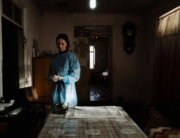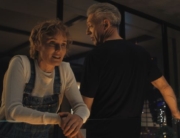Perhaps the two main stories that emerged from this year’s Cannes Film Festival were the jewelry heists (who knew Brian De Palma’s Femme Fatale was so prescient?) and the praise and immediate backlash heaped on the Palm d’Or winner Blue Is the Warmest Color, namely Elaine Sciolino’s piece in the New York Times in which several critics took the film down several notches for its graphic sex scenes.
It’s safe to say that most of the films that have dominated the news coverage were by the better known directors (guilty as charged). But not every one of the some 90 films had red carpet coverage or even a review on Imdb.com. It’s easy to ignore the serious, star-less films when glamour can overpower the festival, where, night after night, mobs of filmgoers in evening dress line up for the invitation-only screenings. (It’s a sight to see an elegant gentleman in a tux panhandling for tickets.)
By way of Iran, Manuscripts Don’t Burn justifies a festival’s mission: offering an international platform for a hard-to-see film, one clandestinely made under severely restrictive circumstances. It’s shocking that Manuscripts was made on location. I would list the names of the cast and crew accordingly, but it was made anonymously for fear of reprisals. When first announced as part of the line-up, it was called Anonymous.
It’s hardly the first film by an Iranian filmmaker to be made surreptitiously and smuggled out. In 2009, directors Mohammad Rasoulof and Jafar Panahi were banned from making films, accused of making anti-government propaganda, but most likely arrested for supporting the pro-democracy candidate in that year’s presidential election. Under house arrest and banned from travel, Panahi responded with This Is Not a Film, setting it solely in his apartment building and recorded on an iPhone.
Rasoulof’s six-year prison sentence was reduced to a year on appeal after he had been jailed for 17 days. Now out on bail, he has continued to have a career (Goodbye came out in 2011), and he made it to Cannes for this premiere. He takes to the streets, roaming all over Tehran and the northern countryside, filming in widescreen HD. Like Panahi’s film, he not only condemns the current regime for violating free speech and freedom of assembly (among many rights), he coolly and emphatically accuses Iran’s secret security service of carrying out assassinations of artists and intellectuals, accused of being a “cultural NATO” for selling their souls to foreigners.
The synopsis follows the outline of a political thriller. A government henchman threatens a 60-something writer and former political prisoner, Kasra, to hand over his too-revealing memoir. The government knows Kasra has been working on something covertly—the writer’s phones are tapped and Kasra’s building is under surveillance. Kasra will agree to turn over his manuscript, but only if he’s allowed to leave the country and join his daughter in Paris. If the government fails to deliver on its promise, he threatens that his work will be published: he has hidden away two copies. However, the mild mannered Kasra has no idea what he’s up against. The internal spy agency has a good inkling as to where the other two remaining manuscripts are hidden.
Two hit men carry out the government’s orders with a cold, robotic efficiency. Only one, Khosrow, has doubts about the morality of his job, expressed stylistically when he takes a shower and ends up doused in blood. Except for these moments that blur reality with a nightmare, this is a grounded, symbolic-free production (and a contrast to Rasoulof’s mesmerizing and allegorical 2009 film White Meadows).
The director makes his fiction (though inspired by real-life events in the late 1980s and ’90s) firmly plausible by focusing on the day-to-day doldrums of the two enforcers. The film observes rather than thrills, methodically demonstrating: this is how it happens. Because of this tone and the even-keel direction, the film avoids the trappings of a screed. It’s actually a quiet but angry work—Rasoulof leaves the indignation for the viewer—and it won the International Federation of Film Critics award for best film in Un Certain Regard, the sidebar for films less conventional (or simply not in the competition.)
Actress Golshifteh Farahani also hails from Iran and has been similarly banned, though for quite a different reason. She’s forbidden from returning to her home country after she posed nude in a French women’s magazine (photos which would be rated PG in this country). Her career started in Iran and has since gone international (see Chicken with Plums and the upcoming The Patience Stone). She now lives in Paris and co-stars in what could be described as a Kurdish Western, Hiner Saleem’s My Sweet Pepper Land, where two outsiders take on a lawless town. The main mode of transport is on horseback and everyone, from the police to henchmen, carries a rifle.
It takes place in 2003, right after the toppling of Saddam Hussein, in the mountainous borderland shared with Turkey. Policeman Baran (hunk Korkmaz Arslan) has gladly accepted a post as sheriff in a remote village to avoid his stubborn mama’s matchmaking machinations (Baran’s predecessor was murdered). He immediately butts heads with Aziz Aga (Tarik Akreyi), the unofficial boss of the fiefdom, who insists on calling the shots. All the protection money trickles down to him, and he demands that the independent schoolmarm Govend (Farahani) be fired as the gossip-hungry community’s only teacher. A 28-year-old woman, he insists, shouldn’t be in a position of power but at home, married with children.
Though the conflict is starkly painted in black and white (the film made largely with money from France and Abu Dhabi), it’s still something of an ambiguity-free romp, and one of the more enjoyable films at Cannes. The lead actors have chemistry, and with Baran’s hazel eyes and Govend’s high cheek bones, what else do you need? The entire cast is movie star good-looking, so much so that an all-female Kurdish militia group looks like they barged in from a Bond film.
First-timer Diego Quemada-Diez takes on undocumented immigration to the U.S. in La Jaula de Oro, encompassing almost all of the disasters that might occur on a migrant’s odyssey from Guatemala through Mexico, whether on foot, riding on top of train cars, or traversing the Rio Grande. Here again, another filmmaker refrains from making a diatribe. Quemada-Diez fleshes out his three main characters, all baby-faced 15-year-olds (their parents and families are nowhere to be seen). They don’t always get along, since the two guys both have the hots for Sara, who has bound her breasts and wears boy’s clothes for safety on the trek—not that that precaution avoids trouble. (She had cut off her long hair in part to pay for what becomes an incident-packed journey.) More times than not, she acts as a peacemaker between the two bickering boys, convincing Juan to share his food with Chauk, an Indian who doesn’t speak Spanish. (But did the teenaged Karen Martinez have to be filmed nude twice, including in a voyeuristic shower scene?)
The film has the look of both a faux-verité (plenty of background extras looking at the camera) and a small-scale epic (filmed on Kodak stock!), set against beautiful vistas in the mountains and plains of Mexico. Steadily involving, it’s the opposite of Cary Fukunaga’s frenetic and thriller-like Sin Nombre. Yet there are jolts because the director doesn’t foreshadow what will happen. The three are at the mercy of other migrants and the Mexican border police, among other hazards. Many fellow travelers look out for each other, but there are those who see the migrants as ripe for exploitation.
The storyline blunders briefly when a white, middle-aged Minuteman makes a micro-second appearance to a fatal effect, as though the writers have piled on all of the possible travails they could imagine. This vigilante comes out of nowhere and already feels out of date. That faulty step aside, the point of view is effortlessly empathetic. In a year where there have already been numerous films showcasing great non-professional casts (Berlin and Tribeca award winner The Rocket, for example), this one joins the ranks. The film credits more than 650 migrants for appearing in the film, and the Un Certain Regard jury singled out the ensemble for an acting award.
Brooklyn-based Chilean director Sebastián Silva is everywhere. His Crystal Fairy will be released in July, and his Magic Magic (just as trippy, but much more sinister) was screened in the Directors’ Fortnight, a showcase for up-and-coming directors, though the suddenly-prolific Silva, having made five films already, has already arrived, it’s safe to say.
A not-entirely-innocent Californian her first time abroad, Alicia (Juno Temple, equally ubiquitous) has just gotten off the plane in Chile to visit her cousin, only to be whisked away on a long road trip to a remote coastal island in the south. Danger ahead: there’s limited phone service. Then at a rest stop, her cousin bails, explaining she has to return to Santiago for school, leaving Alicia stuck with three boisterous, condescending, and often rude strangers. It doesn’t help to break the ice when she accidentally drops one of their laptops in a lake.
The alpha-male Austin (Agustín Silva, the director’s brother) and his mugging sidekick Brink (Michael Cera) shoot and kill an exotic parrot, leave deformed puppies out in the wilderness to die, and throughout, the air is thick with sexual tension, all of which repels Alicia. Because of this and that her body clock is off, she never lets her guard down. She hasn’t slept, no matter how many sleeping pills and anxiety medication she gulps down, risking a reaction with the stash of various other meds in her luggage.
Silva deliberately jerks the tone from grotesquely comic to menacing, except that Michael Cera’s persona often comes off as too goofy, with a mouth as rubbery as Harpo Marx’s—he’s more bewildering than frightening. In contrast, star Juno Temple dives into the deep end. Her performance alone could induce jet-lag, though it’s time for her to give up on using her mop of tangled hair as a shield and character tic. As this vacation from hell is seen through Alicia’s eyes, it becomes a discombobulating experience. However, for viewers stuck on this island for 90 minutes with three boisterous extroverts and one semi-catatonic, semi-hysteric guest, it’s like coming down with a case of both schizophrenia and high cabin fever.
In 2010, British filmmaker Clio Barnard made one of the remarkable documentaries in years, The Arbor, about the northern English working-class playwright Andrea Dunbar and the dark legacy she left her family. This time around, Barnard remains in the north (her hometown of Bradford) for her first feature narrative, The Selfish Giant. She embraces the Ken Loach and Shane Meadows brand of realism in her very loose take on Oscar Wilde’s short story. The beautiful garden has been transplanted to a scrap yard, where two teenage boys bring in stolen cables, which are stripped for their cooper, sold for scrap, bringing in much needed money.
The obscenity-spewing Arbor (Conner Chapman) has an out-of-control temper, exacerbated by not taking his ADHD meds—pills that his older brother has stolen to sell on the street. For defending his bullied mate, the heavy-set Swifty, Arbor’s kicked out of school; the principal to his mum: he doesn’t fit in at a mainstream school. Pal Swifty (Shaun Thomas) is one of at least eight children. His dad doesn’t pay the bills, comes home drunk, and beats his cowering mother. Though the film begins incongruously with horses grazing in a field, this is British miserablism times 10. Even in this bucolic scene, there’s a nuclear power plant in the background.
The plot takes at least an hour to take off. Eventually the heavy exposition leads to a powerful ending, which is probably why the movie won the Label Europa award, given by an organization of art houses that will provide backing for its theatrical release. And apparently there’s life after Downton Abbey. In a 180-degree departure from that show’s scheming Miss O’Brien, actress Siobhan Finneran plays Swifty’s abused, soft-spoken mum. She and the boys are wonderful.
After nearly a week of viewing films featuring graphic slaughterhouse footage and dismemberment, it was startling to hear uproarious laughter throughout Les Garcons et Guillaume, à table!, appropriately translated to Me, Myself and Mum. It’s based on an assumedly autobiographical one-man play by the film’s self-effacing star/writer/director Guillaume Gallienne of the Comédie-Française. But it’s really all about his self-involved mother, whom he also plays in the best drag performance I’ve seen on film, and that’s including Tootsie.
He has created a multidimensional and demented matriarch/drama queen, and it took me several minutes to realize that it was Gallienne in the blond wig and large framed glasses exhaustedly lounging about in designer threads. Teenager Guillaume so admires his mother’s self-assurance that he wants to be her, fashioning his wardrobe after hers and mimicking the tone of her voice, much to his father’s confusion. Everyone, besides his family, assumes he’s gay. The comedy should be a hit on the GLBT festival circuit, and the Société Réalisateurs Français, which programs the Directors’ Fortnight, gave it the equivalent of a best film award for reminding the Cannes audience that it was okay to laugh. Lightweight, but winningly amusing.








Leave A Comment